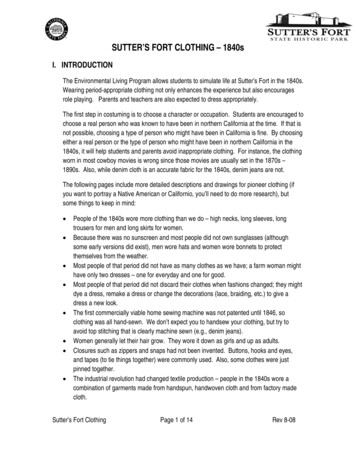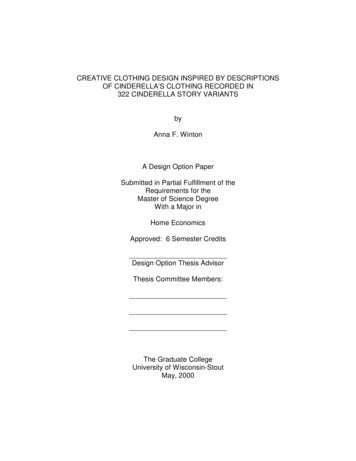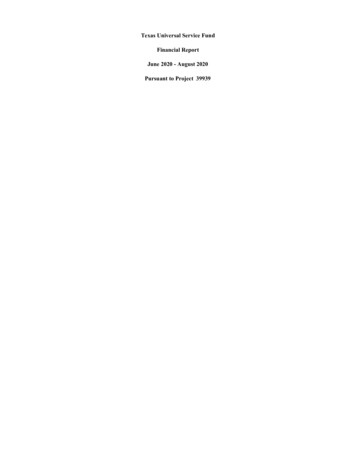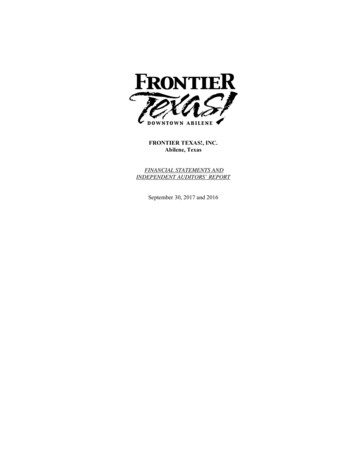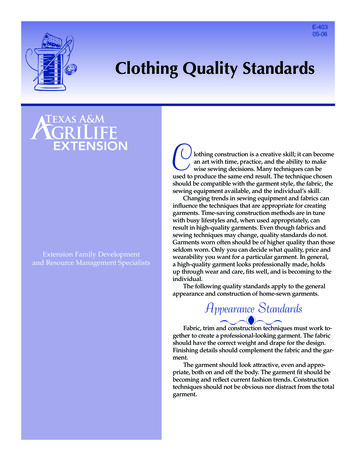
Transcription
E-40305-06Clothing Quality StandardsCExtension Family Developmentand Resource Management Specialistslothing construction is a creative skill; it can becomean art with time, practice, and the ability to makewise sewing decisions. Many techniques can beused to produce the same end result. The technique chosenshould be compatible with the garment style, the fabric, thesewing equipment available, and the individual’s skill.Changing trends in sewing equipment and fabrics caninfluence the techniques that are appropriate for creatinggarments. Time-saving construction methods are in tunewith busy lifestyles and, when used appropriately, canresult in high-quality garments. Even though fabrics andsewing techniques may change, quality standards do not.Garments worn often should be of higher quality than thoseseldom worn. Only you can decide what quality, price andwearability you want for a particular garment. In general,a high-quality garment looks professionally made, holdsup through wear and care, fits well, and is becoming to theindividual.The following quality standards apply to the generalappearance and construction of home-sewn garments.Appearance StandardsFabric, trim and construction techniques must work together to create a professional-looking garment. The fabricshould have the correct weight and drape for the design.Finishing details should complement the fabric and the garment.The garment should look attractive, even and appropriate, both on and off the body. The garment fit should bebecoming and reflect current fashion trends. Constructiontechniques should not be obvious nor distract from the totalgarment.
2.Fabric Coordination and SelectionFabric(s) should: Be suited to the pattern design. (Read thepattern envelope for information concerningone-way designs, napped fabric, knits, etc. Inexperienced sewers should use the fabrics recommended on the pattern envelope.) Have the same care characteristics or be easilyremoved for laundering/dry-cleaning. (Thisapplies to trims also.) Be flattering to the personal characteristics,style and coloring of the individual. Coordinate with one another in terms of design,color, weight and texture. Have balanced grain. (In woven fabrics thelengthwise and crosswise threads will be atright angles unless cut on the bias. In knit fabrics the courses and ribs will be at right angles.) Have a fiber content and texture suited to apparel design. Have a design that is matched, centered or balanced. Be used so that the nap runs in the same direction on all parts of a garment.Fabric Preparation Have proper waistline length and fit. Have darts and design details that are properlyplaced. Have correct and properly placed shoulderlength unless the design dictates otherwise. Have neckline and armholes that fit the bodywithout gapping or straining. Have skirt or pant length appropriate for thestyle and individual. Have sleeve fullness and length appropriate forthe style and individual. Hang straight and parallel.Construction StandardsThere are many sewing techniques that can be used.We each have techniques we prefer—and some that wedon’t. Some standards apply to almost all techniques.For example, almost all construction techniques shouldresult in a finish or detail that is inconspicuous, functional and durable.Armholes and Neckline FacingsWell-constructed armholes and necklines should: Fit smoothly. Neither the neckline seam northe facing should show from the outside of thefinished garment (unless it is designed to bestitched to the outside as a decorative, functional piece). Be the same shape and grain as the edge to befaced (usually 21 2 to 3 inches wide and even inwidth throughout). Be flat, smooth and free from bulk. Have appropriately finished outside edges (according to fabric type/weight) to prevent raveling. Be securely held in place by understitchingand tacking at seams or by top stitching. Aprofessional looking facing will never be handstitched all the way around the outside edge ofthe facing. Be interfaced to prevent stretching and sagging,to cushion the enclosed seam, to reinforce thearea, to support the facing and garment, and toprovide shape.Fabrics properly prepared should be: Preshrunk (laundered or dry-cleaned) using therecommended method of care, including innerfabrics. “Thread perfect,” with lengthwise and crosswise threads at right angles to one another. Todetermine this, pull a thread on woven fabricsand cut along a wale or course on knits. Made “piece perfect,” with lengthwise andcrosswise ends at right angles, if at all possible.FitA properly fitted garment should: Be fashionable and have an attractive fit. Theamount of ease and fullness changes from yearto year according to fashion trends. Fit smoothly over undergarments. Have the appropriate amount of ease for bodymovement.
. 3Buttons and Buttonholes Positioned so that the button can be securedand will ride slightly toward the garment edgein a horizontal buttonhole and toward the topin a vertical buttonhole. Neatly slashed and unsightly threads removed. Made with secure stitching and have uniform“lips.”Well-constructed buttons should: Fit the purpose to which they are intended—functional or decorative. Be neat in appearance on the right and wrongsides of the garment. Be securely fastened with double thread andneat stitches. Have a shank (thread or part of the button) toaccommodate the thickness of the fabric it willbutton through. Be reinforced, according to use and fabric type,with interfacing and/or another button. Be spaced in good proportion between top andbottom opening and in relation to the other buttons.CasingA well-formed casing should: Be flat, uniform and of even width. Have a row of stitching at the top (head) andlower edge of the casing. Be slightly wider than the elastic drawstring.CollarBe placed in relation to the buttonhole on thecenter line or lap line. The placket should besmooth and flat so there is no gaping or pullingwhen buttons are secured in buttonholes.A well-applied collar should: Be smooth and free from wrinkles. The outeredge seam should not be visible from the rightside. Be the appropriate size and style for the garment design and fabric. Have no rough edges.Have smooth curves or sharp points (the sameshape and length) depending on the type andstyle of collar. Be smooth when covered with fabric and haveno “shine” or off-color visible from the base. Have bulk properly distributed through grading/layering, notching, clipping and/or trimming. Fit the neckline area without unsightly gaps orwrinkles. Be interfaced properly to maintain shape. Be understitched on the outer seam edge to rollunder the seam. Be well pressed. Well-constructed buttonholes should be: Neat in appearance on the right and wrongsides of the garment. Flat and attractive. Made with the grain of the fabric unless a biascut garment or unusual design dictates otherwise. An equal distance apart, unless spaced for special design effects. An even distance from the garment edge andaligned with the center line or lap line. Sized in relation to the button size and thickness. Applied to an area that has been properly interfaced. The same length and width when the samesize/shape button has been used. Spaced according to the size of the button andgarment design/function. Buttons and buttonholes should hold a garment securely closedwithout strain or stress.Darts, Ease, Gathers, Pleats, Shirring,TucksA well-constructed fitting dart should: Be directed toward the body curve. Usually end 1 2 to 1 inch from the fullest part ofthe body curve. Be tapered so it is smooth and free of puckers. Be even and smooth in appearance. Be pressed before being crossed by another lineof stitching. Have threads secured at both ends by tying aknot, lock stitching or back-stitching (use onlyon medium to heavy fabric or in a seam line).
4.Well-constructed gathers, pleats, shirring andtucks should: Usually use a single thread for hand-workedhems and basting and a double thread to securehook and eyes, snaps and buttons, and to tackseams. Be neat and well formed, appropriately spaced,and secured with no thread ends showing orunsightly thread “mess” visible.Be invisible on the right side when hemming ortacking seams. Be distributed evenly and/or in accordancewith the garment design. Be even and smooth in appearance. Hang straight without pulling. Have ease for comfort but appear as a straightsilhouette (pleats). Provide relaxed but defined fullness. Theymay be used in place of gathers or fitting darts(tucks).HemsFasteners(Hooks and Eyes, Snaps, Self-Gripping)Well-constructed, well-applied fasteners shouldbe:A well-made hem should: Be inconspicuous on the right side, except whenit is a decorative part of the garment design. Be an appropriate distance from the floor. Be even in width and an appropriate depth forthe fabric and garment design. Appropriate for the garment design and fabricbeing used. Applied to an area that has been reinforcedwith interfacing.Be free from bulk in seams that fall within thehem area. Secured so that stitches do not show on theright side of the garment/fabric.Have fullness eased in and evenly distributedfor a smooth, flat appearance. Appropriately placed so edges are held together smoothly and evenly.Have an edge appropriately finished for thetype and weight of fabric and hem stitch to beused. Used appropriately. Use a straight eye whenedges lap, round eye when edges meet, hooksand eyes for strain openings, and snaps forareas with little stress. The ball side of a snapand the loop side of a self-gripping fastener areplaced on the overlap side. Be firmly secured with a hem stitch appropriatefor the fabric and the hem edge finish. Be neat with evenly spaced hand stitches 1 2 inchapart and with about 1 8 inch give (or have evenmachine stitching). Be lightly pressed.Hand StitchingInterfacingA well-made hand stitch will:A suitable, well-applied interfacing should: Be appropriate for the outer fabric’s fiber content, care and construction type (knit, woven,non-woven) and for the manner in which it isapplied (sew-in versus fusible). Interfacing fabrics range from commercially designed fabricsto self-fabric. Be, or have, the same “grain” or “give” as theouter fabric with which it is used. Coordinate in color as closely as possible. Usea light color with light-colored fashion fabricsand dark with dark. Provide the appropriate support or reinforcement needed to improve the shape of the garment or area. Interfacing is used in the appropriate locations in a garment.Be composed of a thread type, weight/thickness and color suitable to the situation forwhich it is used. Buttonhole twist is used forhand-worked buttonholes and can be used forsewing on buttons and for top stitching. Heavier and decorative threads, such as embroideryand metallic, can be used for decorative stitching. Use the same color, or slightly darker, whenpermanently stitching. Have a uniform stitch formation that is appropriate to the fabric and garment for which it isused. Have thread ends appropriately secured at thebeginning and ending of the stitching. If a knotis used in permanent stitching, it should be outof sight against an inside layer of fabric.
. 5 Not alter the color or hand of the outer fabric.If an appropriate weight cannot be found, it isbest to use a lighter interfacing than a heavierone.PressingA well-pressed garment should: Maintain the original texture of the fabric. Appear flat and smooth with no bubbles,wrinkles or folds. Show no shine or press marks on the right sideof the fabric. Not be visible or noticeable from the outside/right side of the garment. Have no wrinkles or crinkled areas. Have seams and darts pressed smoothly on thestitching line, so that the fabric does not foldover the stitching line or look bubbled. Edges ofseam allowances and fold edges of darts do notform ridges on the right side of the garment. Have no water-spot or steam marks. Help create and maintain the proper shape andcurve to the garment and the various garmentsegments (collar, sleeve, etc.). Suit the design, so it may vary in type andweight within the same garment. Multipletypes and weights of interfacing could be useddepending on the area and function.MarkingsMarkings should: Be appropriate for the fabric. Not show on the right side of the fabric. Not leave holes or discoloration in the fabric.Machine StitchingSeams, Seam Finishes, Seam TreatmentsA well-constructed seam should: Be smooth and even in appearance on theinside and outside of garment. Machine tension, stitch length and presser foot pressure areproperly adjusted to suit the fabric and thread. Be even in width throughout. Be secure. Be pressed open (and with no puckers) orpressed properly according to the type of seamit is and the way it is used in garment construction. Be stitched with thread appropriate to the fabrictype, fabric content and color. (Thread colorshould match or be slightly darker than thefabric.) Have consistent stitch length. Be flat and trimmed and/or graded, if needed,to reduce bulk. Match fabric designs such as plaids and stripes.A well-made stitch will: Use a thread type and needle size appropriateto the fabric and situation for which it is used.Generally, the finer the fabric, the finer theneedle and thread. (Thread expands to or takesup the entire area created by the needle.) Thereshould be no excessive holes created by theneedle.Be a controlled, consistent length appropriateto the fabric and situation for which it is used.As a general rule, the heavier the fabric, thelonger the stitch; the lighter weight the fabric,the shorter the stitch. Within this rule adjustments are made according to fabric texture andstructure.Have equally balanced top and bottom threadsthat look the same on both sides of the fabric(appropriate thread tension).Be the type of stitching (regular sewing machine or overcast/serger) or stitch pattern (standard or decorative) appropriate to the fabricand situation for which it is used.A well-applied seam finish: Is appropriate to the type and weight of fabric. Is smooth and neat in appearance inside andout. Be appropriately secured at the beginning andend of the line of stitching. Does not create excess bulk. Be spaced an appropriate distance from theedge of the fabric according to the function ofthe stitching. Is not visible from the right side of the garment. Is even in width throughout. Uses understitching to “roll under” an enclosedseam and is not visible on the right side. Uses reinforcement stitches on areas of stress. Be neat, straight, and fit the purpose for whichit was done (functional or decorative).
6.SleevesA well-constructed and correctly fitted set-insleeve should: Have a smooth, rounded cap with no pleats orgathers unless they are a garment design feature.WaistbandA well-constructed waistband should: Be smooth, flat, and free from bulk and wrinkles. Be even in width according to the garmentstyle. Be applied so that there is ease in the underarmarea and in the sleeve cap area. Have a good armhole line resulting fromstraight, even stitching, and well-matched seamlines that conform to the body.Be on-grain and reinforced or interfaced tomaintain shape. Have a crosswise grain parallel to the floor, alengthwise grain perpendicular to the floor, andno diagonal wrinkles.Have underlap under the waistband and extendbeyond the placket unless the pattern indicatesdifferently; overlap should be even with theplacket unless the pattern indicates differently. Have evenly distributed gathers in gatheredset-in sleeves.Have the skirt or pants eased slightly on thewaistband. Have seams finished appropriately for the fabric.Have square corners at the ends of the waistband. Be comfortable with no binding.Be securely stitched with smooth, even stitching. Have appropriate fasteners that are properlylocated and secured in place.A well-constructed shirt sleeve should: Be correctly positioned on the body. Be shaped properly and on-grain. Not have gathers or puckers.A well-constructed sleeveless garment should:Zippers and Zipper PlacketsA well-constructed zipper placket and well-applied zipper should: Be flat when closed and neat in appearance. Thezipper should lie smooth without stretching orpuckering of the fabric. Hug the body without binding. Fit the curve of the arm accurately. Have a facing seam that is graded, understitched, free from bulk, smooth and flat.Have smooth, even stitches, evenly spaced fromthe placket edge. Have stitching across the bottom opening 1 8inch beyond the zipper stop. Have thread ends secured and hidden in foldsof fabric so that they will not be caught in thezipper teeth. Be a weight compatible with the fabric (lightwith light, heavy with heavy). Have the facing tacked loosely at seams. Be 1 2 inch from the underarm.TopstitchingTopstitching should: Be a straight line or smooth curve, whichever isappropriate. Have stitch length (usually longer) and tension (usually looser on top) appropriate for thefabric.Have seam lines matching, if the zipper crossesa seam. Have matching fabric design, if needed, such asstripes and plaids. Have the ends of the stitching pulled to thewrong side to secure appropriately.
. 7A well-constructed zipper placket should:A zipper should be: Be properly prepared and pressed before thezipper is inserted. Be sized to the zipper length. Leave 1 4 inch at the top of a neckline zipper fora fastener.Suited in terms of weight, size and length tothe garment design, the fabric and the openinglocation on the garment. Its color should matchor coordinate with the fabric color. Be the same length on both sides.Concealed beneath the edge of a placket overlap from top to bottom. Positioned to fit the placket opening. The placket should open to the end of the zipper teethand close at the top of the zipper. (There shouldnot be a “hole” above a skirt/pant or necklinezipper placement.)This publication was adapted from “Clothing Quality Standards,” developed by Cynthia Klumpp,Master Clothing Volunteer Coordinator with the Cooperative Extension Service at the University of Arkansas.
Fabric, trim and construction techniques must work to-gether to create a professional-looking garment. The fabric should have the correct weight and drape for the design. Finishing details should complement the fabric and the gar-ment. The garment should look attractive, even and appro-pr


